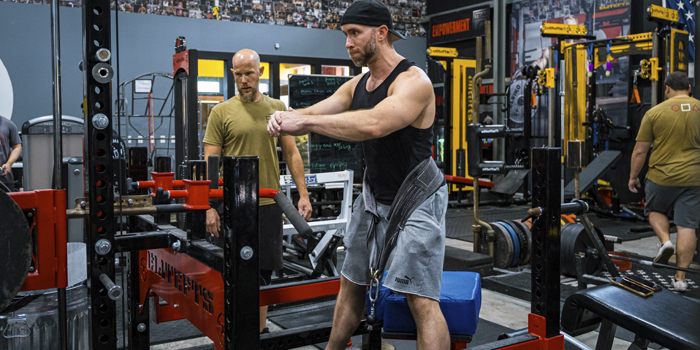
Introduction
Brazilian Jiu-Jitsu (BJJ) martial arts demands a unique blend of strength, endurance, flexibility, and technique. A comprehensive strength and conditioning program tailored specifically for BJJ practitioners is essential to improve performance on the mats and reduce the risk of common injuries associated with this sport. To enhance performance in BJJ, we will cover the following:
- Needs analysis
- Common Injuries
- Programming Examples
- Cutting Weight Properly
Need Analysis
Understanding the physical demands of BJJ is crucial in designing an effective training regimen. BJJ requires a combination of strength, endurance, agility, and flexibility. Practitioners often grapple intensely for extended periods, demanding aerobic and anaerobic conditioning. BJJ athletes need explosive strength for takedowns, grip strength for controlling opponents, T-spine mobility, hip mobility, and core stability and balance during ground techniques. An ideal sports performance program for BJJ should address all of these specific demands from a physical performance perspective.
Common Injuries
Injuries are common in BJJ due to the dynamic nature of the sport. Joint injuries like knee and shoulder issues, strains, and sprains are frequent. The repetitive movements and constant pressure on joints during grappling can lead to overuse injuries. Neck and lower back injuries are also prevalent due to the twisting and bending motions involved in various techniques. Any coach who writes a BJJ program should help prevent these injuries by improving joint stability, strengthening muscles, and enhancing overall mobility. Warm-ups and cool-downs can address some of these problem areas in the BJJ community.
Warm-Ups Should Include:
- Ankle, Hip, T-Spine, and Shoulder
- Core Stability
- Posterior Glute and Shoulder Activation
- Neck Training
Cool-Downs Should Include:
- Low Back Decompression
- Static Stretching
- Box Breathing to Increase Parasympathetic Domination
Programming Examples
A well-rounded strength and conditioning program for BJJ should encompass various elements. Resistance training focusing on compound movements like squats, deadlifts, and presses helps build overall strength. I advise you not to train more than three days per week if you are a serious BJJ competitor. With most BJJ athletes training three to six times per week, programming can be frustrating if you do not know how to give the athletes what they need. To help combat this issue, I have broken these programming examples into two training tenures. See below:
Tenure 1: Novice (2 days per week)
Day 1: Moderate Volume/Moderate Intensity
1A. 4x6 – Squat – 70 percent or RPE 7=8/10
1B. 4x8 each - cable row – Load to form
1C. Hip mobility of choice (whatever muscles are tight)
Hang from bar x 30s
On-the-minute work: 15-20 minutes total
2A. Minute 1: 8 Chin grip lat pulldowns
2B. Minute 2: 6 each Single leg machine leg curl
2C. Minute 3: 30s Plank
2D. Minute 4: 8-12 Cal Assault bike
2E. Minute 5: 8-12 Cal Rower
Day 2: Moderate Volume/Moderate Intensity
1A. 4x6 – Bench – 70 percent or RPE 7=8/10
1B. 4x6 each - Single Leg DB RDL– Load to form
1C. T-Spine Mobility x 5 on each side
Hang from bar x 30 seconds
On-the-minute work: 15-20 minutes total
2A. Minute 1: 8 Chest-Supported DB Flys
2B. Minute 2: 6-8 each DB step ups
2C. Minute 3: 20s Side Plank each
2D. Minute 4: Down and Back DB Carry
2E. Minute 5: Down and Back - Sled backward drag
Justification
Note there is not much power training present. For novice individuals, lifting weights is going to be enough to increase their power-out for at least the first six to twelve months of training. The on-the-minute training is typically good enough to keep most BJJ athletes well-rounded from a conditioning perspective. Most BJJ competitors train on the mats three to five days per week, on top of the weight room training. This volume of time on the mats should be accounted for from a musculoskeletal and conditioning perspective, depending on the goal of the black belt instructors.
Coaches who train BJJ athletes should use all these considerations to create a flexible training program. Utilizing multiple options for movements and understanding progressions/regressions/variations will assist greatly in the programming as well, especially when your athletes get injuries, both minor and major. As a coach, you must monitor any acute or major injuries from the training by keeping a good relationship with the competitor and BJJ gym coaching staff. When in doubt, honesty and trust will take you farther than a well-written strength and conditioning plan will.
Tenure 2: Intermediate and Advanced (2 to 3 days per week)
Day 1: Max Effort/Dynamic Effort/Moderate Volume Accessories
Maximal Effort Upper Body (Heavy bench press, weighted pull-ups, etc.)
- Work up to heavy five rep max bench press (Do Not Compensate)
Dynamic Effort Lower Body (Speed squats, box jumps, lower intensity barbell lifts for speed, etc.)
- Trap Bar Deadlift Speed Pulls 10 x 2 at 55 percent of 1 rep max, 55-second rest.
Repetition Effort (total body focus)
- 4x8 DB Incline Bench
- 4x8 Each Single Leg Machine Leg Curl
- 4x 30 sec Plank
- 3x8 reps Chin Ups (weighted if possible)
- 3x20 reps Calf Raises
- 3x20 Chest supported T's
Cool-down
- Static Stretching for 30 seconds on all muscles used
- Hang From bar for 30 seconds for low back decompression
Day 2: Dynamic Effort/Dynamic Effort/Higher Volume Accessories
Dynamic Effort Lower Body (Speed squats, box jumps, lower intensity barbell lifts for speed, etc.)
- Front Squat 12 sets x 2 reps at 50 percent of 1 rep max, 55-second rest.
Dynamic Effort Upper Body (Speed bench press, explosive push-ups, etc.)
- Bent Over Row 12 sets x 3 reps at 50 percent of 1 rep max, 55-second rest.
Repetition Effort (total body focus)
- 4x8 Chest Supported Row to W
- 4x6 Each Lateral Lunges
- 3x10 Barbell Shrugs
- 3xDown and Back Crossover Sled March
- 3x10 DB Curl to Press
- 2xMax Kneeling Tricep Pushdowns
Cool-down
- Static Stretching for 30 seconds on all muscles used
- Hang From bar for 30 seconds for low back decompression
RECENT: Why DUP is Superior for Tactical Athletes
Day 3: Max Effort/Dynamic Effort/Moderate Volume Accessories
Maximal Effort Lower Body (Heavy squats, deadlift variations, etc.)
- Work up to a heavy three-rep max Sumo Deadlift (Do Not Compensate)
Dynamic Effort Upper Body (Speed bench press, explosive push-ups, etc.)
- Incline Bench Press 10 sets x 3 reps at 55 percent of 1 rep max, 55-second rest
Repetition Effort (total body focus)
- 4x10 Wide Grip Lat Pulldown
- 4x8 Barbell Glute Bridges
- 3x Down and Back Sled Backwards Drag
- 3x Down and Back 1 Arm Farmer Carry
- 3x10 Cable Curls
Cool-down
- Static Stretching for 30 seconds on all muscles used
- Hang from bar for 30 seconds for low back decompression
Justification
Please note that in the intermediate and advanced tenure section, you do not see a ton of EMOMs, AMRAPs, etc. This is because the majority of the conditioning base is built, and hopefully, the coach will only need to maintain it. I substituted it with repetition effort training to enhance and maintain strength, size, etc. This does not mean those training methods (EMOMs, AMRAPs, etc) cannot be used. However, repetition efforts might prove to be more effective as the athlete's training tenure grows and BJJ competency increases. Both tenures (intermediate and advanced) were also put into the same category because the goal is to become better at BJJ, not a world champion bodybuilder, powerlifter, Olympic weightlifter, etc.
I would argue that lifting in BJJ can be extremely challenging as the athletes gain tenure in the weight room. Low back, neck, and shoulder training should be incorporated into a well-thought-out training plan to reduce the likelihood of injury to at-risk body parts. I would not focus on unilateral or bilateral movements singularly. Utilizing a combination of both on each training day is recommended.
Cutting Weight Properly
Weight management is often a part of competitive BJJ. However, cutting weight should be approached cautiously to avoid compromising performance and health. Gradual weight loss through proper nutrition and hydration is key. Avoid drastic measures like extreme fasting or dehydration, as they can lead to fatigue, reduced strength, and increased susceptibility to injuries. Your athletes need to cut weight, so make sure to give them ample time to achieve the weight goal within their off-season if allowed. If no off-season option is open, avoid high-level competitions until the weight goal can be realistically achieved. Consultation with a dietitian for a personalized weight-cutting plan that preserves energy levels and supports recovery is not only advisable but needed in my professional opinion.
Conclusion
An individually tailored strength and conditioning program is fundamental for enhancing BJJ performance and minimizing the risk of injuries. By addressing the specific physical demands of the sport, focusing on injury prevention, and adopting a balanced approach to weight management, practitioners can elevate their skills and endurance on the mats while maintaining and optimizing fitness levels. Remember, consistency and proper guidance are needed to achieve success both on and off the BJJ mats.
Please feel free to connect by sending me a message on Instagram (@Coach_Telegadas) or by emailing me at my coaching email address: CoachKostaTeleagdas@Gmail.com. I am always open to connecting with anyone who wants to discuss strength and conditioning programming, coaching, etc. Stay strong, stay motivated, and train hard!
Kosta Telegadas is a leader in strength and conditioning for tactical athletes and martial artists worldwide. With over a decade of strength and conditioning experience, Coach Telegadas strives to make a difference in the lives of the tactical athletes he serves. Telegadas also runs Telegadas Performance Training; an online strength and conditioning platform where he primarily remotely trains grapplers, fighters, and tactical athletes alike. He found physical training necessary to grow up playing sports, help prevent injury & give back to the country that gave his family so much over the generations. If you are interested in contacting Telegadas for training programs, please follow/message him on Instagram (@Coach_Telegadas) or email him directly at CoachKostaTelegadas@Gmail.com.











